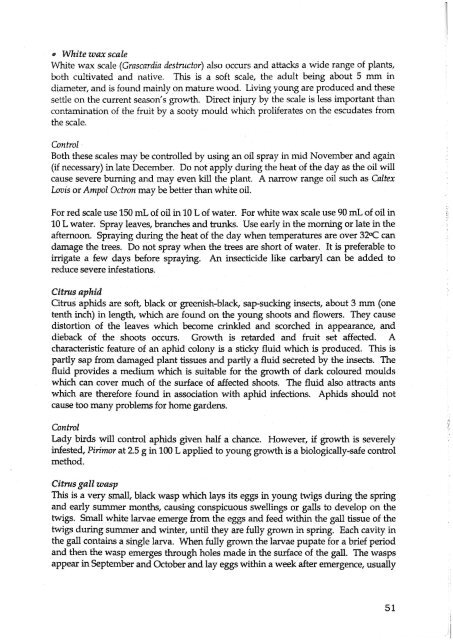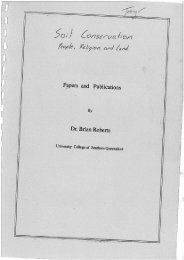western-queensland-gardening-guide.pdf - South West NRM
western-queensland-gardening-guide.pdf - South West NRM
western-queensland-gardening-guide.pdf - South West NRM
You also want an ePaper? Increase the reach of your titles
YUMPU automatically turns print PDFs into web optimized ePapers that Google loves.
mite wax scale<br />
White wax scale (Grasmrdia destructor) also occurs and attacks a wide range of plants,<br />
both cultivated and native. This is a soft scale, the adult being about 5 mm in<br />
diameter, and is found mainly on mature wood. Living young are produced and these<br />
settle on the current season's growth. Direct injury by the scale is less important than<br />
contamination of the fruit by a sooty mould which proliferates on the escudates from<br />
the scale.<br />
Control<br />
Both these scales may be controlled by using an oil spray in mid November and again<br />
(if necessary) in late December. Do not apply during the heat of the day as the oil will<br />
cause severe burning and may even kill the plant. A narrow range oil such as Caltex<br />
Lovis or Ampol Octron may be better than white oil.<br />
For red scale use 150 mL of oil in 10 L of water. For white wax scale use 90 mL of oil in<br />
10 L water. Spray leaves, branches and trunks. Use early in the mo<br />
afternoon. Spraying during the heat of the day when temperature over 320C can<br />
age the trees. Do not spray when the trees are short of water. It is preferable to<br />
gate a few days before spraying. An insecticide like carbaryl can be added to<br />
reduce severe infestations.<br />
Citrus aphid<br />
Citrus aphids are soft, black or greenish-black, sap-sucking insects, about 3<br />
tenth inch) in length, which are found on omg shoots and flowers. They cause<br />
distortion of the leaves which become c d and scorched in appearance, and<br />
dieback of the shoots occurs. Growth is retarded and hit set affected. A<br />
characteristic feature of an aphid colony is a sticky fluid which is produced. This is<br />
partly sap from darn plant tissues and partly a fluid secreted by the insects. The<br />
fluid provides a me which is suitable for the growth of dark coloured moulds<br />
which can cover much of the surface of affected shoots. The fluid also attracts ants<br />
which are therefore found in association with aphid infections. Aphids should not<br />
cause too many problems for home gardens.<br />
Control<br />
Lady birds will control aphids given half a chance. However, if growth is severely<br />
infested, Pirimor at 2.5 g in 100 L applied to young growth is a biologically-safe control<br />
method.<br />
Citrus gall wasp<br />
This is a very small, black wasp which lays its eggs in young twigs during the spring<br />
, causing conspicuous swellings or galls to develop on the<br />
merge from the eggs and feed within the gall tissue of the<br />
in spring. Each cavity in<br />
ae pupate for a brief period<br />
ce of the gall. The wasps<br />
appear in September and October an<br />
after emergence, usually
















